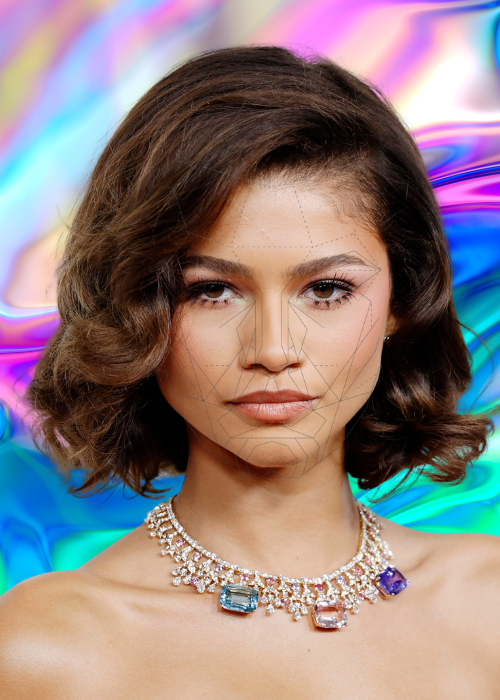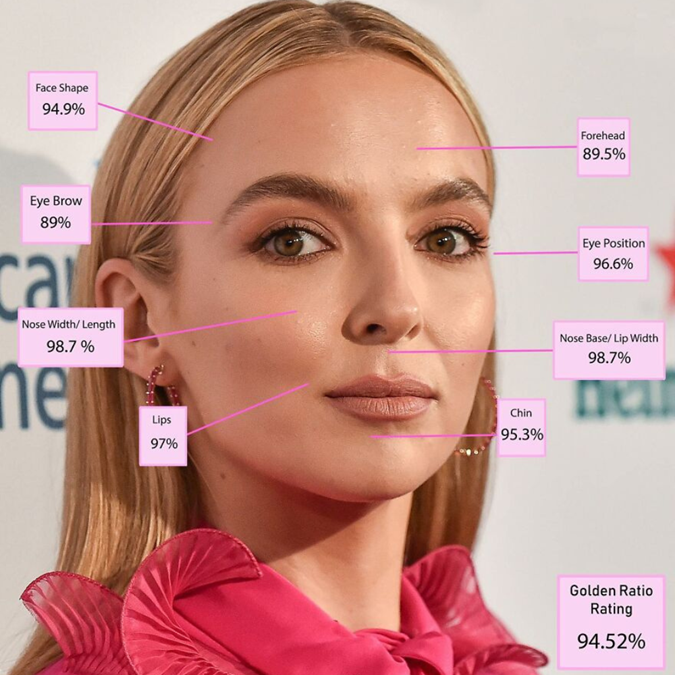Can the ‘golden ratio’ really be used to measure physical perfection?

An expert-lead look at the problematic ‘proportion score’
In 2022, Jodie Comer was named the world’s most beautiful woman, joining the likes of Bella Hadid, Zendaya and Beyoncé. And the one thing these women have in common (aside from A+ genetics, global stardom and unrivalled talent, of course)? Their faces are mathematically perfect.
It turns out that beauty can be calculated, using the golden ratio (AKA Phi) and that math and aesthetics are more closely linked than meets the eye. The golden ratio can be found almost everywhere, from seashells to the Mona Lisa and the Egyptian pyramids. So what does it have to do with beauty? We’re so glad you asked…
First: a quick lesson in history and mathematics (bear with us). The golden ratio actually dates back 2500 years, to when the Ancient Greeks divided a line into two parts in a ratio of 1:1.618, and found the proportions particularly appealing. The term “Phi” is derived from the name ‘Phidias’, a Greek sculptor who utilised the golden ratio to perfect his work.
According to Masterclass, “the golden ratio results when the ratio of two numbers is the same as the ratio of their sum to the larger of the two numbers”. So when it comes to faces, the ratio can be determined by measuring the length and width of the face, then dividing the length by the width – and the closer your measurements are to the golden ratio of 1.62, the more “attractive” you’re deemed to be.
TLDR: the golden ratio is an attempt to measure attractiveness through facial symmetry.
Dr Julian De Silva has made a name for himself as a golden ratio god, using his own computerised facial mapping techniques to crown the queen of the golden ratio. The title is currently held by actress Jodie Comer, with a golden ratio rating of 94.52%. And just behind her, Zendaya scored 94.37%, Bella Hadid scored 94.35%, Beyoncé scored 92.44% and Taylor Swift scored 91.64%.

Image via London Facial Plastic Surgery
Image via London Facial Plastic Surgery
If you’re curious to find out what your golden ratio score is and whether you fit the mould, there are a myriad of TikTok filters and smartphone apps that will ‘score’ your facial features (fun stuff, we know). TikTok’s ‘Face Ratio’ filter currently has 2 million videos, and quite literally warps your face to “perfect” proportions – air warning: you’ll likely end up looking completely unrecognisable.
But as Californian plastic surgeon Dr Monica Kieu notes in her TikTok, beauty is subjective (louder for the people in the back!). So then, why is the golden ratio still referenced so much in modern aesthetics?
According to cosmetic physician Dr Mary Fonti, the golden ratio is useful for assessing a patient’s face when starting out in the field. “I initially relied on using specialised calipers to measure facial proportions based on the golden ratio,” she explains. “It helped me develop an eye for identifying areas that could benefit from dermal fillers to address volume deficiencies. The great thing about these measurements is that they offer an objective way to show patients where too much filler could end up detracting from their natural beauty rather than enhancing it.”
But the reality of being a cosmetic doctor is that people are seeking your skills in pursuit of perfection of some kind. Dr Fonti’s most popular procedures include bioremodelling injections, dermal fillers, thread lifts and anti-wrinkle injections (we’re partial to a lip flip ourselves) – all to treat various concerns such as lines and wrinkles, volume loss and skin rejuvenation.
@dr.prasanthi Never thought I’d use maths again after high school 😂Golden ratio principles to create harmony! #filler #tiktokdoc #fyp #beauty ♬ original sound - monet mcmichael 🤍
With more than a decade of experience under her belt, Dr Fonti has ditched the calipers for a more in-depth assessment of each patient’s face – and mental wellbeing. “In a world where social media can amplify self-consciousness and body dysmorphia, it's crucial to take a step back and delve into the reasons behind these insecurities,” she explains.
“Rather than chasing an elusive idea of perfection, I encourage patients to explore their self-acceptance journey and consider consulting with a psychologist if needed… Nowadays, I'm more focused on factors like skin quality, texture, and enhancing or restoring volume,” she says.
Keep in mind that the ratio and symmetry of your face changes and shifts over time as you age. For example, a loss of skin elasticity (causing lines and sagging) will change the shape of your cheeks. And that nose that was once Barbie-perfect never stops growing which also throws the proportions of your face off.
It’s also worth noting that the golden ratio of beauty is very much based upon the Eurocentric beauty ideal. This really comes as no surprise, given the very problematic lack of diversity in beauty standards. But let’s not forget that beauty standards do shift over time. We’re seeing it right now, with celebrities including the Kardashians, who were once the beauty standard, dissolving their fillers and embracing more of their natural features.
It is for this reason that Dr Fonti insists on a more personalised approach to aesthetics: “Instead of trying to fit everyone's face into a predetermined notion of beauty, my goal is to celebrate each person's unique beauty and enhance it in a way that feels true to them.”
The bottom line? The golden ratio may just be outdated when it comes to modern aesthetics. “I find inspiration in influential celebrities who prioritise a holistic approach to beauty,” Dr Fonti explains, opting to eschew rigid standards in favour of a healthy lifestyle, good skin care practices and the preservation of natural features.
“This emphasis on authenticity and self-expression is far more appealing than trying to fit into a specific mould,” she says. “While the golden ratio still serves a purpose in clinical settings to ensure balanced results, it's not the main focus during cosmetic consultations. As beauty standards continue to evolve, I believe the relevance of the golden ratio will continue to diminish, making room for a more inclusive and individualised approach to aesthetics.”
Main image credit: Getty
Want more expert-approved beauty advice? Check out our latest digital issue...

Georgia Nelson is BEAUTYcrew's Beauty & Social Editor and resident Euphoria obsessee. You'll find her hard at work putting the latest TikTok beauty trends to the test or perfecting her skin care routine. Her latest obsession? Nailing the glazed donut aesthetic (move over, Hailey Bieber).






